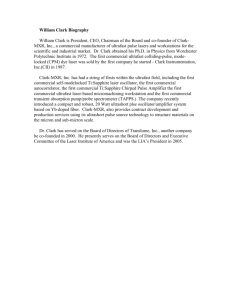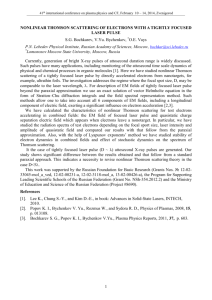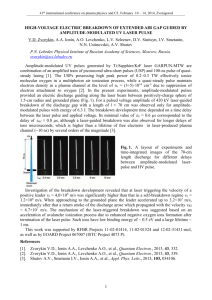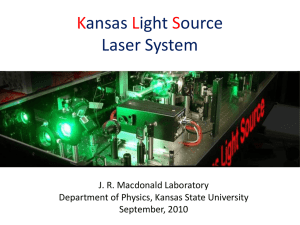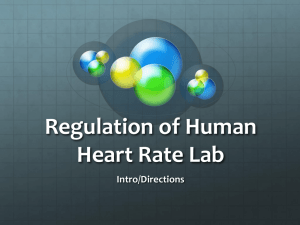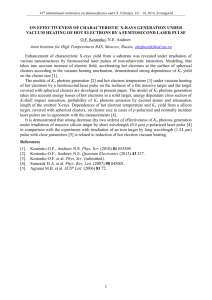lecture #15 ppt
advertisement
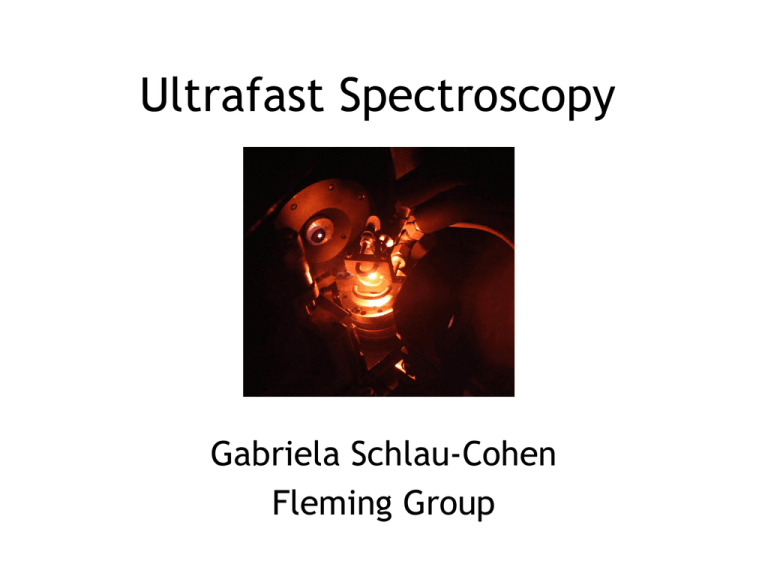
Ultrafast Spectroscopy Gabriela Schlau-Cohen Fleming Group Why femtoseconds? timescale = distance/velocity ~~~~~~ distance ≈ 10 Å E ≈ hν ≈ (6.626*10-34kg*m2/s)*(3*108m/s /6*10-7m) ≈ 3*10-19kg*m2/s2 E= ½mv2 v=√(2*E*/m) =√(2*E*/9*10-31kg) =√(2*3*10-19/(9*10-31 ) m2/s2) v=8*105 m/s ~~~~~~ timescale ≈ (10*10-10m)/(8*105m/s) ≈ 10-15 sec Ultrafast examples: • Photosynthesis: energy transfer in <200 fs (Fleming group) • Vision: isomerization of retinal in 200 fs (Mathies group) • Dynamics: ring opening reaction in ~100s fs (Leone group) • Transition states: Fe(CO)5 ligand exchange in <1 ps (Harris group) • High intensity: properties of liquid carbon (Falcone group) How can we measure things this fast? –6 Timescale (seconds) 10 –9 10 Electronics –12 10 Optics –15 10 1960 1970 1980 Year 1990 2000 Laser Basics Four-level system •Population inversion •Pump energy source Fast decay Pump Transition •Lasing transition Laser Transition Fast decay Level empties fast! What we need for ultrashort pulse generation: • Method of creating pulsed output • Compressed output • Broadband laser pulse Ultrafast Laser Overview pump Laser oscillator Amplifier medium 3 pieces of ultrafast laser system: • Oscillator • Tunable Parametric Amplifier • Regenerative Amplifier Oscillator generates short pulses with mode-locking Prisms Cavity with partially reflective mirror Ti:Sapphire laser crystal Pump laser Titanium: Sapphire • 4 state system • Upper state lifetime of 3.2 μs for population inversion • Broadband of states around lasing wavelength • Kerr-Lens effect (non-linear index of refraction) Al2O3 lattice oxygen aluminum Intensity (au) Ti:Sapphire spectral properties FLUORESCENCE (au) (nm) Mode-locking Mechanism of Mode-locking: Kerr Lens Effect n n0 n2 I ( x ) Compression • Prism compression t • Gratings, chirped mirrors t Chirped Pulse Amplification Short pulse oscillator t • Stretch Dispersive delay line t Solid state amplifiers • Amplify t Pulse compressor • Recompress t Regenerative Amplifier • Pulsed seed • Ti: Sapph crystal s-polarized light Pockels cell • Pulsed pump laser • Pockels cell Faraday rotator thin-film polarizer p-polarized light OPA/NOPA • Parametric amplification • Non-linear process • Energy, momentum conserved “seed" “pump" w1 w3 w1 w2 Optical Parametric Amplification (OPA) "signal" "idler" Non-linear processes (1) (2) P 0 E E 2 (3) P 0 wsig E (5) 3 ... * E1 E 2 E 3 E 4 E 5 Emitted-light frequency “Signal pulse” Medium under study “Excitation pulses” Variably delayed “Probe pulse” Signal pulse energy Time Resolution for P(3) De Two-Dimensional Electronic Spectroscopy can study: • Electronic structure • Energy transfer dynamics • Coupling • Coherence • Correlation functions 2D Spectroscopy • Diagonal peaks are linear absorption • Cross peaks are coupling and energy transfer ωt (“emission”) • Excitation at one wavelength influences emission at other wavelengths Dimer Model (Theory) Excited State Absorption Homogeneous Linewidth Cross Peak Inhomogeneous Linewidth ωτ (“absorption”) Electronic Coupling E E JJ e1 1 e2 D 2 g1 g2 1 Dimer 2 Principles of 2D Spectroscopy τ T t SIGNAL Time t g e i ω3 t e t e | (t ) | g e iw 3 t | e e g ρt ABSORPTION FREQUENCY w1 S EMISSION FREQUENCY w3 3 ( , T , t ) Recovered from Experiment 2D Heterodyne Spectroscopy coh. pop. echo time time time T t 4=LO 1 2 3 sig spectrometer 1 2 3 4 sample OD3 spherical mirror 4 3 1&2 3&4 2 1 diffractive optic (DO) Opt. Lett. 29 (8) 884 (2004) 2f delay 2 delay 1 Experimental Set-up Fourier Transform Future directions of ultrafast • Faster: further compression into the attosecond regime • More Powerful: higher energy transitions with coherent light in the x-ray regime 2D spectrum with cross-peaks A measurement at the amplitude level Positively Correlated Spectral Motion w j w k 0 Negatively Correlated Spectral Motion w j w k 0
